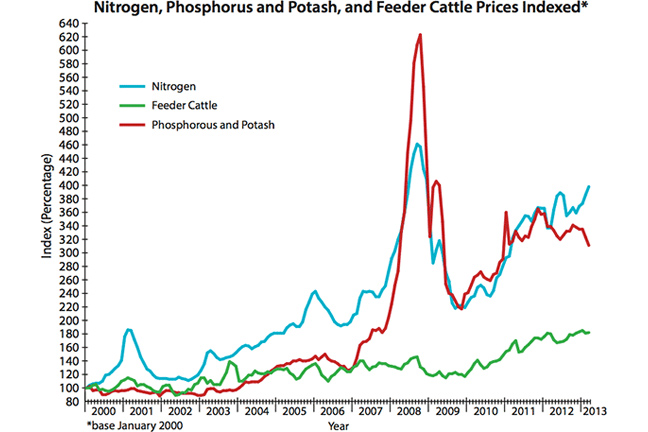
Agricultural News
Does Fertilizer Still Pay for Stocker Operations?
Thu, 02 May 2013 12:12:44 CDT

The following article by Job Springer appeared in the Ag News and Views Newsletter from the Samuel Roberts Noble Foundation:
Cattle operations across the Southern Great Plains are on the cusp of making an important financial decision. Managers need to determine how much, if any, fertilizer should be applied to warm-season perennial pastures. The price of fertilizer has been on the rise, and old rules of thumb can no longer be used with today's high fertilizer and cattle prices.
The graph above shows the indexed prices of nitrogen, phosphorus and potash fertilizers. These are the three most common fertilizers applied to warm-season perennial pastures in the Southern Great Plains. Prices of all three inputs have steadily increased since 2000, suggesting that fertilizer has become less profitable to use. However, we live in a dynamic marketplace where both input and output prices fluctuate. While fertilizer prices have risen, so have beef cattle prices. The graph also shows how feeder cattle prices have changed over the same time period.
So are fertilizer prices too high for stocker cattle operations? To help answer this, we need to set some framework. To start, let's assume a situation where the soil is adequate in both phosphorus and potassium, and we want to analyze taking a 500-pound calf to 650 pounds on bermudagrass starting on May 15 and ending on Aug. 30 - a gain of 1.5 pounds per day. Let's also assume that the ranch is already at full carrying capacity, but the carrying capacity could be expanded by applying additional nitrogen.
Research has shown that, on average, 1 actual pound of fertilizer will generate 30 pounds of dry matter bermudagrass. At current urea prices of 65 cents per pound of actual nitrogen, the additional bermudagrass would cost 2.17 cents per pound. If this stocker calf starts out at 500 pounds and ends at 650 pounds, its average weight during this time is 575 pounds. To gain 1.5 pounds a day, the stocker calf will need to eat 3 percent of its body weight a day (this takes into account waste associated with a calf grazing pasture). This equals an average consumption of 17.25 pounds per day of bermudagrass. Taking the cost of 2.17 cents per pound of bermudagrass and multiplying by 17.25 pounds of grass equals 37 cents per day. Since the calf is gaining 1.5 pounds per day, the cost per pound of gain is 25 cents.
From the value of gain standpoint, the 500-pound stocker calf on May 15 is projected to be worth $162 per hundredweight or $810 per head. On Aug. 30, the 650-pound stocker calf is projected to be worth $154 per hundredweight or $1,001 per head. Value of gain is calculated by taking the difference in price per head and dividing by the weight gain. This equates to $1.27 per pound of gain (($1001 - $891) ÷ 150).
In this scenario, each additional pound the stocker calf puts on costs the producer only 25 cents, but is valued by the market at $1.27. In this case, the producer can expect to receive a net income of $1.02 for each pound of gain, so it would be economical to apply fertilizer. From this net return, the expense of applying the fertilizer should be subtracted. It can be seen that in many situations there would be enough margin available after covering nitrogen and application costs to also cover the additional expense to fertilize less fertile ground that requires phosphorus and/or potassium.
WebReadyTM Powered by WireReady® NSI
Top Agricultural News
More Headlines...



















